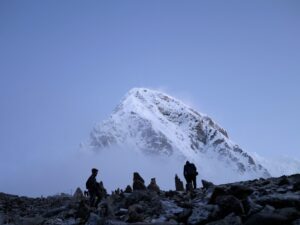Paul Verrico, Head of the EHS Team at Eversheds-Sutherlands, on a new safety theory that mirrors the ascent of the world’s highest mountain.
There is no shortage of empirical research underpinning thinking on health and safety in the workplace. But the science is often remote, which is why communicators rely on hypothetical scare stories. But these, too, suffer from the law of diminishing returns.
When we designed our new safety theory, ROPE, we opted to incorporate hard science into relatable stories, and real-world examples illustrating the effects in practice.
What is ROPE?
Factors such as fatigue, accumulated stress and family pressures are often ignored in a drive towards perfection, when workers are viewed as the ‘problem’ in the event of an incident. An illustration we found both relatable and memorable is the ascents of Mount Everest.
Sir Edmund Hillary, and Sherpa mountaineer Tenzing Norgay, became the first climbers confirmed to have reached the summit of Everest in 1953. Sir Edmund recorded his account: “After an hour’s steady going we reached the foot of the most formidable-looking problem on the ridge – a rock step some 40ft high”, now known as the Hillary Step.
The Hillary Step is a near-vertical rock face, approximately 12m high, near the summit and 29,000 feet above sea level. Climbing the Hillary Step was known as the most technically difficult part of the typical Nepal-side Everest climb and the last real challenge before reaching the top.
Climbing the Hillary Step meant a 10,000ft drop on the right and an 8,000ft drop on the left. However, climbing it unaided was only rated only as a Class 4 rock climb – the Yosemite system for climbing difficulty describes such a climb as “simple climbing, often with exposure. A rope is often used”.

CREDIT: Andreas Gäbler/Unsplash
In The Ascent of Everest, written with John Hunt in 1953, Hilary describes the ‘Step’: “The rock itself, smooth and almost holdless, might have been an interesting Sunday afternoon problem for a group of expert rock climbers in the Lake District, but here it was a barrier beyond our feeble strength to overcome… Despite the considerable effort involved, my progress although slow was steady, and as Tenzing paid out the rope I inched my way upwards until I could finally reach over the top of the rock and drag myself out of the crack onto a wide ledge… As I heaved hard on the rope Tenzing wriggled his way up the crack and finally collapsed exhausted at the top like a giant fish when it has just been hauled from the sea after a terrific struggle.”
In his book Into Thin Air, published in 2011, Jon Krakauer describes his experience of a 1996 Everest expedition in which six climbers died. The expedition season actually recorded eight deaths, including that of Krakauer’s guide Rob Hall. He remarks that “people’s perceptions of their own abilities are amazingly far off the mark” and “one teammate, for example, was reduced to a helpless, infantile state by his infirmities and needed extensive help to make it down to the South Col. And yet he doesn’t seem to remember this; his view is that he was just fine, that he didn’t need any help”.
We can draw parallels from the extreme and incredibly challenging environment of climbing Everest to everyday life. One reference is the civil case of Michael Eyres in the UK (EWCA, 2007) which highlights the risks of fatigue.
On the day of a road accident that left him paralysed, Michael had arrived at work at 3.30am after 4.5hrs sleep, setting off with a colleague to fit a kitchen in Swindon, 111 miles (179km) away. The pair shared the driving and work, which was finished at 2.30pm, when the colleague said they had another job in Sidmouth, Devon, 122 miles (196km) away. The accident happened in the evening while Eyres was driving from Devon to the company’s base in the north. Lord Justice Ward, who gave the ruling of the Court of Appeal, said Mr Eyres, who was 20 at the time, was “in that predicament because his employers had put him there”.
Rest – Rope
In 2003, sleep expert, Dr.Van Dongen led and published research in the journal Sleep. The research found even relatively moderate sleep restriction can seriously impair waking neurobehavioral functions in healthy adults. Sleepiness ratings suggested that subjects were largely unaware of these increasing cognitive deficits, which may explain why the impact of chronic sleep restriction on waking cognitive functions is often assumed to be benign.
We can conclude fatigue is a reason we struggle to perform tasks safely. And, just like Sir Edmund Hillary, what can appear a straightforward job can be anything but. Rest, therefore, forms the first element of ROPE – ensuring teams have adequate opportunity to recover and take appropriate breaks is essential.
Observation – rOpe
The second component of ROPE is Observation. When working we can find ourselves in a job or completing a task that would have seemed beyond us when we started our careers. We take on responsibilities that may seem crushing. When we are under enormous stress, it feels like we are out of oxygen – much like climbers at altitude.
Severe altitude sickness is a medical emergency requiring immediate descent and medical attention. But doing so can be challenging – climbing downhill is harder than trekking uphill. Observing workers’ behaviour is vital if we are to help them perform to optimum levels. Sometimes we need to help an individual ‘move down the mountain’ (reducing their responsibilities) but this in itself could be challenging as they will fear losing status. But in the long run, it may be vital, to protect them, as well as others.
During the pandemic we worked on a case where an experienced operative in a food production company had been promoted to seniority as her colleagues were shielding – and was working extra shifts. She had received all relevant training and reviewed the risk management documentation. The organisation considered her one of their best operatives but management failed to check to see how she was. Following failure to properly supervise an equipment change, a junior operative sustained life-changing injuries.
Stress had affected her performance and judgement leading to a lapse of concentration. The organisation had failed to check in with the worker and did not track and monitor overtime sufficiently leaving her burned out, despite hiding it. A culture of continuous and sympathetic observation could have prevented this.

CREDIT: Michael Clarke/Unsplash
Planning – roPe
Rob Hall made a fatal mistake during the doomed 1996 ascent of Everest. Hall’s party was not the only one attempting to summit during favourable spring weather and, as a result, they had watched a party return having been unable to make the summit.
Hall told Krakauer: “To turn around that close to the summit… that showed incredibly good judgement on young Göran’s [Kropp] part. I’m impressed – considerably more impressed, actually, than if he’d continued climbing and made the top.”
From the perspective of a health and safety professional, Kropp had risk-assessed the hazards considered the likelihood and the foreseeability and had ‘stopped work’ before his actions became reckless. On the day of Hall’s team ascent, they failed to stick to the agreed plan of a turnaround time of 2pm – when his team reached the summit it was after 4pm. The results were catastrophic.
When we investigate incidents, it is important to realise people act rationally at the point of decision-making because there are strong initial cues that suggest the situation is under control and can be continued without changing the likelihood of misfortune. If things change slowly, people can fail to respond in a timely way, becoming situationally blind.
Planning means considering what skills workers need in a changing environment and to do this we must consider the metrics and data that must be gathered to become a learning organisation. Purely-reactive planning will expose employees to risk. Proactive management of work activities will help mitigate these risks and enable the work to be completed as imagined.
Empowerment – ropE
Krakauer explains how as he began his descent, he noticed wispy clouds forming around other Himalayan peaks but thought nothing of it. A fellow climber who was a pilot later told Krakauer that in his experience wispy clouds are sometimes the “crowns of robust thunderheads”. Yet that life-saving information was never passed to guide leaders – they were not empowered to share their informed views with the expedition leader, Hall.
Our theory draws from Conklin and Hollnagel:“…if Planning involves ensuring that workers have the ability ‘to be able to do work in a varying and unpredictable world.”(Conklin, 2017) or “…having the capacity to make things go well,” (Hollnagel, 2014), then empowerment is about giving local teams the ability to speak up and act in accordance with their training, rather than sticking by rote to policies that were made off-site for work as an imagined task rather than for work as done.
A vital piece of empowerment is culture – to start developing a good culture, leaders should encourage open discussion, work collaboratively with employees and encourage them to develop and question the way things are done. Good health and safety empowerment within the workforce can assist in driving down incidents and increase overall productivity.
Learning from Everest
The ROPE theory suggests completing the same tasks repeatedly under different conditions can be more difficult when suffering from fatigue, stress or anxiety, and this can lead to a disaster.
Sir Edmund Hillary conquered the ferocious conditions on Everest by modelling safety behaviours from which we can all learn. A rope is part of the fundamental equipment for successful climbers. Likewise, we believe ROPE is a key strategy for senior managers and safety practitioners to navigate the high altitude of the workplace safely.
The Safety Conversation Podcast: Listen now!
The Safety Conversation with SHP (previously the Safety and Health Podcast) aims to bring you the latest news, insights and legislation updates in the form of interviews, discussions and panel debates from leading figures within the profession.
Find us on Apple Podcasts, Spotify and Google Podcasts, subscribe and join the conversation today!




What a great analogy.